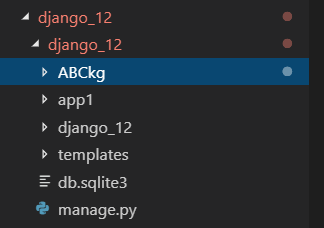在django项目根目录位置创建scrapy项目,django_12是django项目,abckg是scrapy爬虫项目,app1是django的子应用

2.在scrapy的settings.py中加入以下代码
|
1
2
3
4
5
6
|
import osimport syssys.path.append(os.path.dirname(os.path.abspath('.')))os.environ['django_settings_module'] = 'django_12.settings' # 项目名.settingsimport djangodjango.setup() |
3.编写爬虫,下面代码以abckg为例,abckg.py
|
1
2
3
4
5
6
7
8
9
10
11
12
13
14
15
16
17
18
19
20
21
22
23
24
25
26
27
28
29
30
31
32
33
|
# -*- coding: utf-8 -*-import scrapyfrom abckg.items import abckgitem class abckgspider(scrapy.spider): name = 'abckg' #爬虫名称 allowed_domains = ['www.abckg.com'] # 允许爬取的范围 start_urls = ['http://www.abckg.com/'] # 第一次请求的地址 def parse(self, response): print('返回内容:{}'.format(response)) """ 解析函数 :param response: 响应内容 :return: """ listtile = response.xpath('//*[@id="container"]/div/div/h2/a/text()').extract() listurl = response.xpath('//*[@id="container"]/div/div/h2/a/@href').extract() for index in range(len(listtile)): item = abckgitem() item['title'] = listtile[index] item['url'] = listurl[index] yield scrapy.request(url=listurl[index],callback=self.parse_content,method='get',dont_filter=true,meta={'item':item}) # 获取下一页 nextpage = response.xpath('//*[@id="container"]/div[1]/div[10]/a[last()]/@href').extract_first() print('即将请求:{}'.format(nextpage)) yield scrapy.request(url=nextpage,callback=self.parse,method='get',dont_filter=true) # 获取详情页 def parse_content(self,response): item = response.meta['item'] item['content'] = response.xpath('//*[@id="post-1192"]/dd/p').extract() print('内容为:{}'.format(item)) yield item |
4.scrapy中item.py 中引入django模型类
|
1
|
pip install scrapy-djangoitem |
|
1
2
3
4
5
6
7
8
9
10
|
from app1 import modelsfrom scrapy_djangoitem import djangoitemclass abckgitem(djangoitem): # define the fields for your item here like: # name = scrapy.field() # 普通scrapy爬虫写法 # python" id="highlighter_362789">
6.在django中models.py中一个模型类,字段对应爬取到的数据,选择适当的类型与长度
7.通过命令启动爬虫:scrapy crawl 爬虫名称 8.django进入admin后台即可看到爬取到的数据。 到此这篇关于django结合使用scrapy爬取数据入库的方法示例的文章就介绍到这了,更多相关django scrapy爬取数据入库内容请搜索服务器之家以前的文章或继续浏览下面的相关文章希望大家以后多多支持服务器之家! 原文链接:https://blog.csdn.net/shiguanggege/article/details/114279146 延伸 · 阅读
精彩推荐
|










